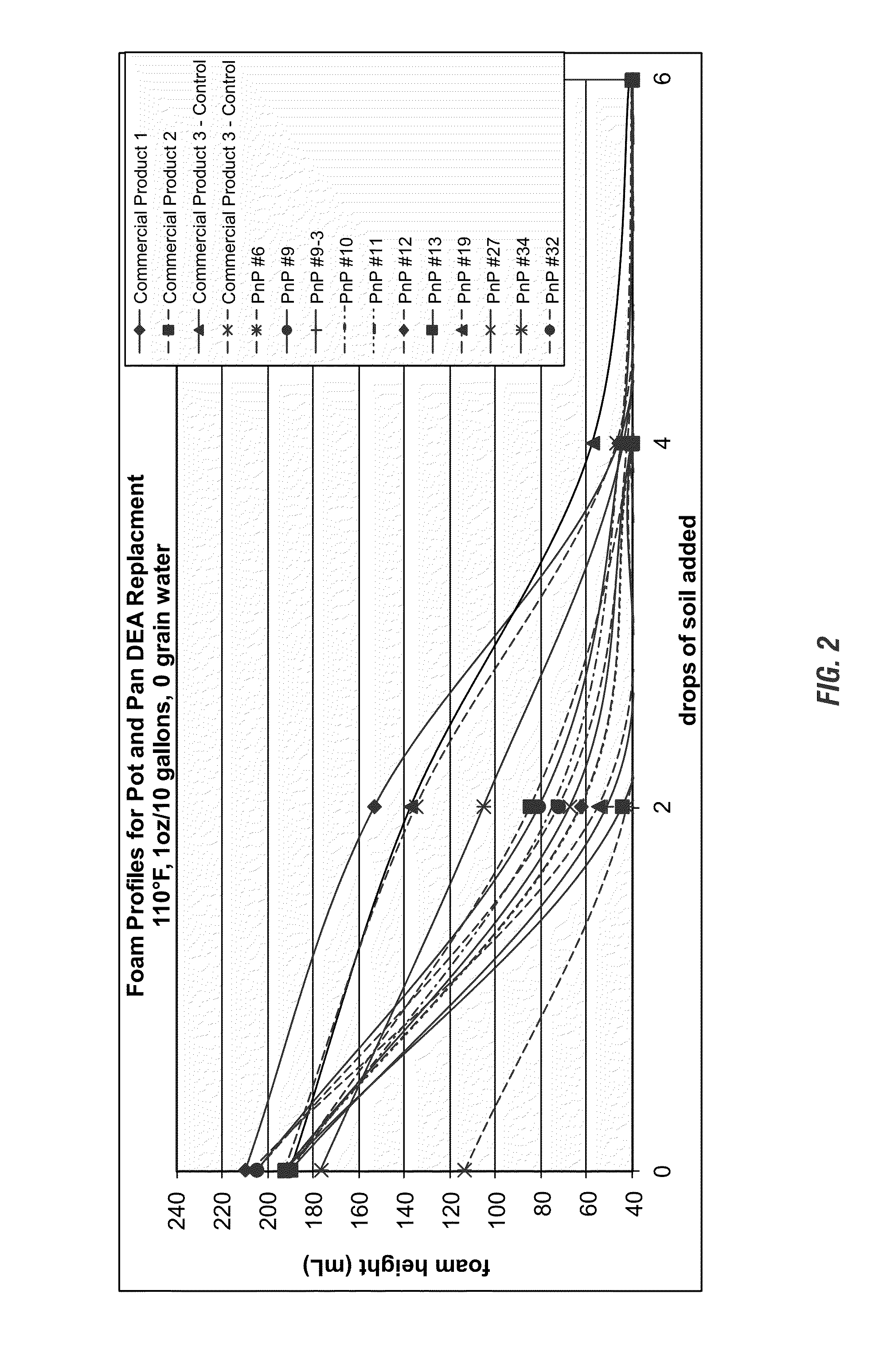Foam stabilization with polyethyleneimine ethoxylates
a technology of polyethyleneimine and ethoxylate, which is applied in the direction of ampholytes/electroneutral surface active compounds, hair cosmetics, cleaning using liquids, etc., can solve the problems of cocamide dea being criticized
- Summary
- Abstract
- Description
- Claims
- Application Information
AI Technical Summary
Benefits of technology
Problems solved by technology
Method used
Image
Examples
examples
Manual Pot and Pan Cylinder Foam Test Method
Purpose:
[0228]To screen hand dish washing detergents for foam height and stability.
Scope:
[0229]This procedure applies to any hand dish washing product.
Apparatus and Materials:
1. Cisco Shortening
2. Flour
3. Powdered Egg
4. Oleic acid
5. Disposable pipets
6. Guwina-Hoffmann rotation device
7. Ground glass stoppered graduated cylinders (250 ml)
8. Rubber stoppers
9. Hop plate with variable heat adjustment
10. Water bath / heat chamber
Soil Formula:
1. 45% Crisco Shortening
2. 30% Flour
3. 15% Powdered Egg
4. 10% Oleic
Equipment Setup:
[0230]Calibrate the Guwina-Hofmann rotation devise to 30 rpm.
Procedure:
[0231]1. Prepare solutions. Test solution is 500 ppm active surfactant (not to include SXS).[0232]2. To a 250 ml graduated cylinder, add 40 mls of test solution. Repeat this step for each product. Label all cylinders.[0233]3. Loosen stoppers and heat cylinders containing solutions to 80° F. and a second set to 110° F.[0234]4. Liquefy soil on a low temperature...
example 2
Foam Results with Fixed Active Surfactant Concentration Dosing
[0244]The following foam results were obtained with fixed active surfactant concentration dosing, so the effectiveness of each surfactant / polymer system can be more easily compared.
[0245]FIGS. 11, 12, 13, and 14 clearly show the benefit of enhanced foam when using the PEI ethoxylate. Specifically comparing the Commercial Product 3 control formula to formula #14, they are identical except the 11.7% active cocamide DEA in the control is replaced with the 0.5% (as is) Sokalan HP-20.
[0246]Additionally, by increasing the amine oxide when using the PEI ethoxylate serves to increase the total foam even more as can be seen in FIG. 11 with formulas #20, #26, #41, and #45.
[0247]FIGS. 13 and 14 show the same results as FIGS. 11 and 12 but at 110° F. instead of 80° F., that the PEI ethoxylate as a foam enhancement replacement for DEA is feasible and in fact is actually superior to cocamide DEA.
[0248]FIGS. 15 and 16 shows that the foa...
example 3
Emulsification of soil, and long term foam stability (stability of foam at certain time after agitation stops):
[0253]This testing results suggest that Cocamide DEA appears to help long term foam stability (Commercial Product 3) (20 minutes after agitation stops), while AO does not (#9). However, PEI ethoxylate+4-6% AO provides even better long term foam stability. Also, compositions with about 13.7% AO, and PEI-14 PEG-10 / PPG-7 (Commercial Product 1) demonstrated poor long term foam stability. This yet again contrasts the difference between PEI ethoxylate and PEI-14 PEG-10 / PPG-7 used by the commercial products. See FIG. 34.
(I) Processing Issues Associated with High Percent Amine Oxide:
[0254]The results shown in FIG. 25 indicate that at higher amounts of amine oxide (above 8%) the viscosity of the product becomes too high.
(II) Oily Soil Emulsification / Incorporation in the Foam Phase:
[0255]We have run foaming experiments with Sudan red dyed corn oil (for visual identification of where ...
PUM
| Property | Measurement | Unit |
|---|---|---|
| wt. % | aaaaa | aaaaa |
| wt. % | aaaaa | aaaaa |
| wt. % | aaaaa | aaaaa |
Abstract
Description
Claims
Application Information
 Login to View More
Login to View More - R&D
- Intellectual Property
- Life Sciences
- Materials
- Tech Scout
- Unparalleled Data Quality
- Higher Quality Content
- 60% Fewer Hallucinations
Browse by: Latest US Patents, China's latest patents, Technical Efficacy Thesaurus, Application Domain, Technology Topic, Popular Technical Reports.
© 2025 PatSnap. All rights reserved.Legal|Privacy policy|Modern Slavery Act Transparency Statement|Sitemap|About US| Contact US: help@patsnap.com



